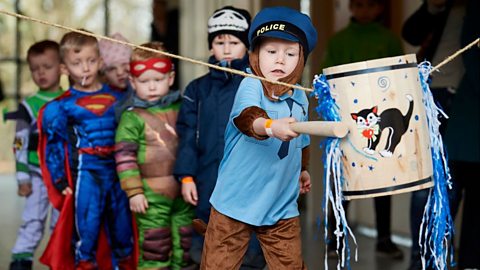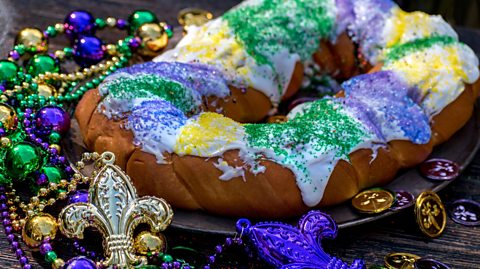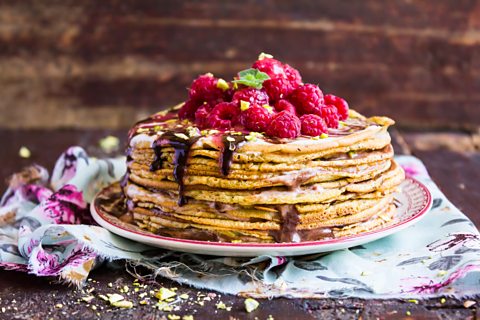ItŌĆÖs the annual tradition that starts the countdown to Easter by testing our flipping skills.
Shrove Tuesday is the day before Lent begins and thereŌĆÖs nothing we like batter ŌĆō sorry, better ŌĆō than marking it by eating pancakes.
The day is known to many as Pancake Day, and in the UK, traditional toppings such as lemon and sugar still come out as the nationŌĆÖs favourites ahead of things like chocolate spread or even ice cream.
How do people celebrate Pancake Day in other countries?
┤¾Ž¾┤½├Į Bitesize takes a look at Pancake Day and its equivalents around the world.
Denmark
The Danish equivalent of Pancake Day is known as Fastelavn and actually takes place on the Sunday before Shrove Tuesday ŌĆō seven weeks before Easter Sunday.

ItŌĆÖs an old tradition in Nordic countries and sees children dressing up in costumes to go trick-or-treating for money or a Fastelavnsboller ŌĆō a sweet bun typically filled with jam or cream. Historically, they were made as a way of finishing dairy products before Lent began, when Christians would traditionally give up certain foodstuffs until Easter.
Children also play a game hitting barrels decorated with pictures of cats and filled with sweets, similar to a Mexican pi├▒ata. Whoever knocks the bottom section of the barrel off is declared the Cat Queen, while the person who takes off the final board of the barrel becomes the Cat King.
Lithuania
In Lithuania, the traditional Shrove Tuesday celebrations are known as U┼Šgav─Śn─Śs ŌĆō a festival that marks the end of winter and the beginning of Lent.
At major celebrations in the country, an effigy of winter known as Mor─Ś is burnt while a staged battle takes place between La┼Īininis, who represents winter and Kanapinis, who represents spring ŌĆō with Kanapinis always coming out on top.
Pancakes are on the menu on U┼Šgav─Śn─Śs ŌĆō believed to be because their round shape symbolises the Sun. Toppings typically include sour cream, fruit sauces and even caviar ŌĆō but youŌĆÖre expected to have a big appetite on the day itself.
Lithuanians are encouraged to eat around a dozen meals on the day, in preparation for fasting which begins the following day.
USA
Mardi Gras is celebrated around the world on Shrove Tuesday. This French name means Fat Tuesday and the day again sees fatty foods consumed before Lent begins.
ItŌĆÖs probably best known in the US for the parades that take place in New Orleans, Louisiana.

One of the foods most associated with Mardi Gras is king cake. The New Orleans version is a mix of coffee cake and cinnamon roll and is typically decorated in yellow, green and purple icing ŌĆō the colours of Mardi Gras. It has fruit and cream cheese fillings alongside another, less obvious addition ŌĆō a small, plastic baby figurine that symbolises Jesus.
Finding the baby in your slice is said to mean youŌĆÖre in for a year of good luck ŌĆō but itŌĆÖs not without its responsibilities too. If your piece of cake is accompanied by the figurine, you have to host the festivities the following year, and supply the cake too!
It's a tradition that dates back to the 1950s in Louisiana. Early European recipes for king cake added a dried bean, which was said to give good luck to whoever found it. McKenzie's, a bakery in New Orleans, were persuaded to add the figurines as they would be easier to find.
McKenzie's didn't originally intend the baby to represent anyone in particular, but it's widely considered in New Orleans today to be a symbol of Jesus. These days, the baby is typically placed outside or underneath the cake, rather than being baked into it, to keep everyone safe - but it's always worth double checking your slice thoroughly for anything inedible, just in case.
Poland
In Poland, the pre-Lent celebrations take place a little earlier than in the UK.
On the Thursday before Lent begins, people across the country take part in T┼éusty Czwartek ŌĆō which literally means Fat Thursday ŌĆō by eating fatty, sugary food before abstaining in the run up to Easter.
The main item on the menu is P─ģczek ŌĆō a large, fried doughnut filled with jam or marmalade and glazed with sugar. ItŌĆÖs believed that if you donŌĆÖt eat any P─ģczki on the day, then youŌĆÖll have a year of bad luck.
Another treat thought to symbolise good fortune is Faworki ŌĆō a pastry made in the shape of angel wings and covered in sugar.
This article was published in February 2022
The science to help you win on Pancake Day
How chemistry, physics and maths can help you excel at Shrove Tuesday

Why does the date of Easter move around?
There's a reason why it's a moveable feast - find out why here.

Four places of worship built in remarkable places
Malaysia's 'floating' mosque, cliffside temples in Bhutan and a French church housed within a tree
